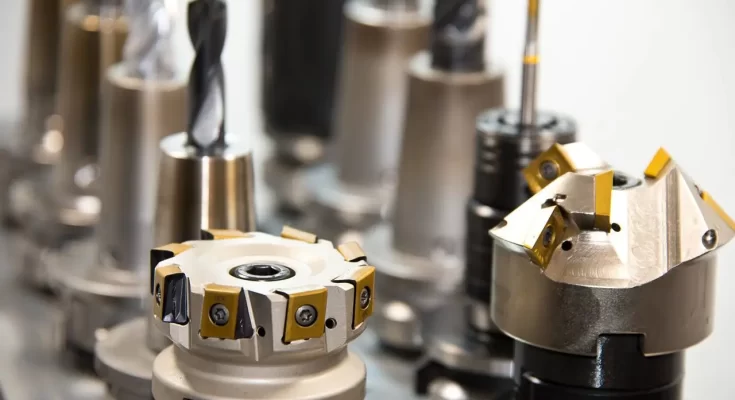Precision tools are the linchpin of premium machining. These tools do more than cut; they improve your craft. Materials are shaped with both care and accuracy. Picture this: tools that rapidly remove layers, increasing efficiency without compromising the quality or precision of the surface.
Lower costs and workpiece protection during cuts are benefits of these tools’ extended life. Efficient operation is a given, with these advanced cutters efficiently handling any complex geometry thrown at them—a step toward seamless production synergy where man meets machine for excellent results. What we’re looking for is hitting the optimized sweet spot of all three, referred to as machining effectiveness.
Maximizing Material Removal Rates
To maximize material removal rates, you need to optimize your tools. High-quality precision cutting tools like carbide or new ceramic inserts make a huge difference in machining. Follow the tool manufacturer’s guidelines for chip load and adjust cut settings as needed.
Newer CAD/CAM software with these capabilities helps significantly by maintaining consistent conditions during cuts. Sure enough, embracing newer strategies improves cycle times up to 70%, slashing production costs! You’ll want to match machine capacity with tool performance, combining high feed rates or deep stepovers where appropriate.
This translates directly into dramatic cost savings and increased shop efficiency across various industries.
Ensuring Superior Surface Finish Quality
Quality control proves to be the backbone of precision machining, crucial for achieving that impeccable surface finish. With a keen focus on maintaining standards and consistency, here’s how precise cutting tools play an integral role
- Dimensional Inspection: Measurement accuracy is key in quality assurance for machined parts. This step ensures each component matches exactly with its intended design specifications. Precise tools allow exacting checks of dimensions and tolerances during production—critical tasks when aiming for unparalleled detail.
- Process Monitoring: Continuous monitoring catches errors before they escalate into larger problems. Cutting-edge CNC machines equipped with sensors track tool wear and operational anomalies in real-time—vital feedback necessary for immediate adjustments enhancing both machine performance and end-product uniformity.
- Process Documentation: Every process leaves a footprint that’s important to record; documentation preserves this trail effectively within machining operations, ensuring transparency across all aspects—from initial tool calibration right through final inspection stages, including meticulous verification steps vital in meeting strict manufacturing quotas without fail.
Achieving Tight Tolerances in Machining
Achieving tight tolerances in CNC machining requires precision tools. Think 0.005 inches or less deviation from specified measurements. This level of accuracy is crucial for industries like aerospace and medical devices, where tiny discrepancies can have major impacts on product functionality.
To produce such precise components consistently, you need advanced technology and a skilled team that adheres to stringent quality control protocols. Material selection also plays a significant role; different materials hold tolerances differently under the stress of manufacturing processes. By specifying exact dimensions upfront, you ensure that parts fit perfectly into their larger assemblies without sacrificing performance due to unwanted variance.
Remember, while tighter tolerances equate to higher costs due to more involved production techniques like specialized inspections or additional finishing methods, this expense pales next to the cost overruns from having unusable parts due to poor tolerance adherence. It’s all about striking balance: employ tight tolerances smartly for critical features but avoid unnecessary expenses on non-critical aspects by allowing looser yet functional variances
Extending Tool Life and Reducing Cost
- Tool Life Optimization: By monitoring real-time data to pinpoint the optimal tool replacement time, you improve both lifespan and output quality. Instead of guessing when a tool might fail or produce out-of-spec parts, accurate analytics identify precise changeover points—extending your tools’ performance without risking defective products.
- Efficiency in Machining Operations: You can maximize your return on investment by managing tool life effectively with thorough knowledge informed by comprehensive data collection from machine tools themselves. This approach guarantees that each cutting instrument is utilized to its full potential before being changed out, circumventing unnecessary costs and downtime associated with premature or belated replacements.
- Preventing Production Setbacks: Leveraging predictive insights about tool wear prevents work stoppage and reduces scrap due to overused equipment leading past their expected lifespans undetected—instrumental for continuous high-precision manufacturing processes where even slight deviations impact overall production quality significantly.
Preventing Workpiece Damage During Cutting
To prevent damage to your workpiece during cutting, you need precise tools with advanced coatings like titanium nitride or diamond-like carbon. These reduce friction and wear, safeguarding the intricate details of your machined components and sharpening and replacing worn parts. It prevents inaccuracies stemming from tool degradation while ensuring consistent performance.
Moreover, specialized tools are indispensable for complex machining tasks such as multi-axis milling or precision turning. They ensure accurate cuts in line with stringent specifications necessary for elaborate designs. Manufacturers often overcome challenges in maintaining this high level of accuracy by optimizing cutting parameters and leveraging effective cooling strategies.
Expect continuous advances in these tools; smart technologies equipped with sensors will soon revolutionize precision further by offering real-time data to refine processes on the fly
Adapting to Complex Geometries with Precision
In high-precision machining, adapting tools to complex shapes is vital. Your project’s success hinges on selecting the right equipment that can accurately cut intricate designs without error. Modelcraft Co.’s advanced CNC technology ensures precision for diverse materials and configurations due to its progressive approach to tooling and quality control processes.
This capability directly benefits industries such as medical or aerospace, where precise components are non-negotiable. Precision instruments from a facility like ours meet stringent standards, ensuring parts fit perfectly every time—a must when lives or critical operations depend on faultless manufacturing.
Precision cutting tools are vital for machining high-quality products. They ensure accurate cuts, leading to components that fit perfectly and function as intended. With precise tools, errors decrease, and consistency improves across production runs.
This precision boosts efficiency by reducing waste material and rework due to defects or poor fits—a must-have for any workshop focused on delivering exceptional workmanship while saving time and costs associated with materials. Therefore, strong attention to the quality of your cutting tools directly correlates with the caliber of your finished pieces.




